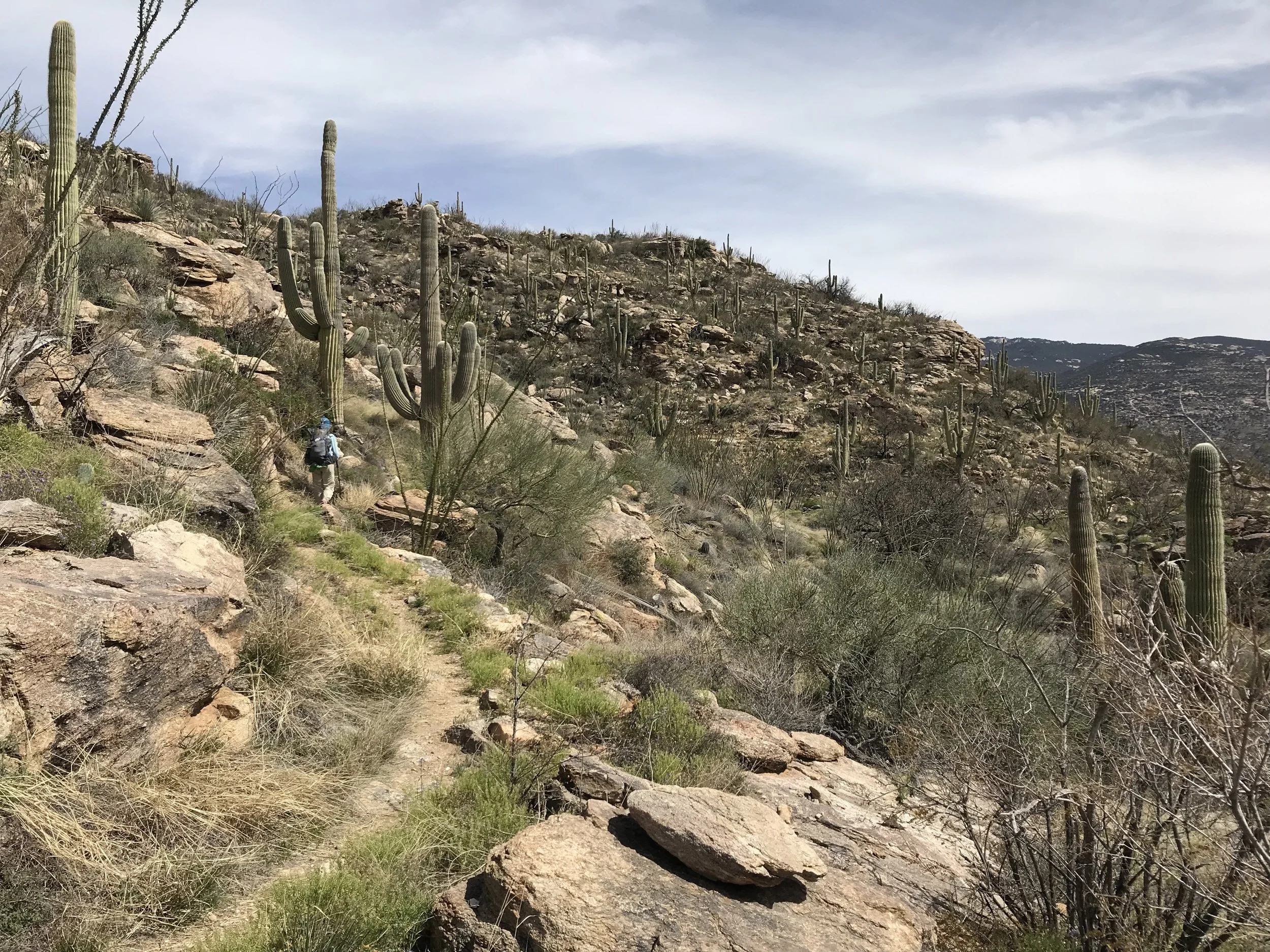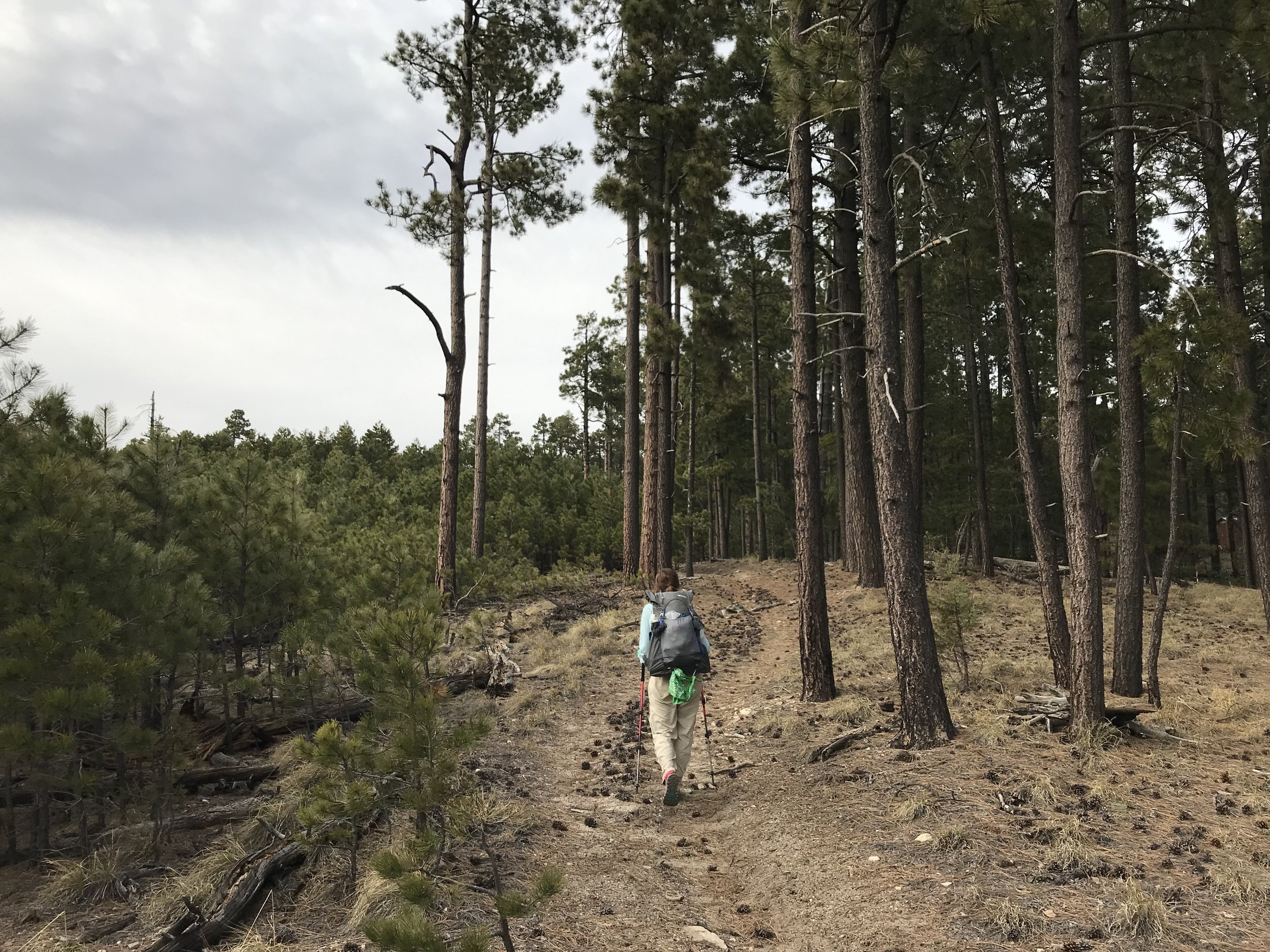Arizona Trail - Day 13 - Saguaro National Park at Manning Camp
Date: March 26, 2019
Trail Mile 140
Today was my toughest day physically so far on the trail. Knowing we had a 5000 ft. ascent from the low Sonoran desert in Rincon Valley to Manning Camp in the snow at 8000 ft. meant we planned to get up at the first crack of light - to flee the rising heat with the coming exertion. We had previously done a backpack trip to Manning Camp two years prior and knew this climb was exposed, REALLY hot, waterless for long stretches, and rocky. The route just climbs a ton of elevation ceaselessly before you round a corner into a thick old growth ponderosa forest stretching for miles along the top.
The hiker we ran into the evening before passed us heading southbound and waved as we packed up. Suddenly, she turned and returned. She sported a large buck rack on her backpack. Looking for approval, she said she found the antlers in the National Park and wanted to know (she knew I was an environmental science teacher from our conversation the evening before) if there were any negative ecological consequences with taking them. I talked carefully about Leave No Trace outdoor ethics, and she responded, stating she wanted a scientific explanation. I responded that Leave No Trace was indeed based on decades of science from when the parks were severely degraded in the 1960s/1970s by human impact. She responded by saying that the national parks had taken so much from people and animals; this was a way to take something back (I still don’t understand this statement). I believe she was seeking some salve for her consciousness, knowing that if an environmental science teacher gave approval, then it really was fine. She asked if there were any other scientific reasons beyond Leave No Trace. I spoke about how rodents will often gnaw on antlers for the calcium stores. She considered this, thanked me, and continued on. I was inwardly disappointed that despite her approaching me with this issue, she still decided to keep it. Finished with packing, I headed back to Rincon Creek to fill up all our water bottles for the long hot climb. As I was crouched in the creek filling water, that same hiker approached me again, from the far bank. I waved and greeted her. Again, she was back to talk to me about the antlers. She said she had gotten rid of them. Acknowledging her actions as a good call, I waved goodbye. Whether she actually did, I’m not sure, but I really hope so. Her decisions definitely weighed on her enough to come back to me twice. After my NOLS course, Leave No Trace is something that I work on every time I recreate in the outdoors.
After all this, Janna and I grabbed our backpacks and walked along thickening stands of Saguaro. We arrived at the boundary to Saguaro National Park, opened the AZT gate, and entered the foothills of the Rincons where some of the densest stands of saguaros and largest individuals on the planet live. The washes we always saw as dry had trace water flows going. We didn’t know what the top would bring. Guthook comments suggested that just days earlier, people were still breaking trail through 2 feet of snow. These lower wash flows, normally dry, were evidence of a solid snowpack on high.
Beginning the climb, the temperatures rapidly increased as the sun moved to the middle sky. We both were drenched with sweat, slowing our pace to avoid overheating, taking constant sips of water and taking some salt pills. Brittlebush blooms at their zenith or just past chocked the spaces between saguaros, creosote, and palo verde with massive spreads of daisy-like blooms. The temperature kept rising and we both made sure pants and long sleeves were on to avoid a burn. But keeping covered kept that heat more concentrated. Considering the amount of water I was guzzling (and salt pills I was taking), I estimated that easily sweat 5 L of water that day, and never peed once.
Midway up the mountain, we arrived at Grass Shack, a backcountry campground in the National Park sitting at about 5000-6000 feet along a creek with crushing with cold water. Large Arizona oaks and alligator junipers lined the riparian spot as we had transitioned out of the low desert, through the grassland high desert, and were firmly in a scrub-oak transition zone. We tore off our shoes and socks to just soak our feet and legs in the snow melt creek. Two backpackers came by, students at the University of Arizona, out for a weekend trip. They joined us with the feet soaking. With a fresh batch of cold water and having snacked and rested, Janna and I pushed upwards. It was about this time that I started getting a terrible headache. I kept needing to stop, close my eyes, and cool down to not exacerbate what I estimated to be a suddening migraine born of mounting heat stress and high elevation, plus a push from dehydration.
The forest cover turned from low growing junipers and oak mottled with agave and yucca to massively tall stands of ponderosa pine, firs, and a few spruce. We knew the push to the top would be deceiving for the summit. Rounding a bend, we ran into two guys doing an overnight trip who were completely destroyed by the ascent. They said we had to be close, but Janna and I knew there were easily still 2+ miles to go. They sat on their packs and looked as we pushed on. I was super curious if we were going to run into Chris, that same hiker we hung with at Colossal Cave from the day before but we didn’t see him. Rounding a bend, big snow drifts lined the trail and some north facing slopes on high. A large stream cascaded down a narrow gorge lined with alpine tree species. Janna and I finally made it to the top at Manning Camp at the cusp of dimming evening and I was completely physically wasted and with my migraine leaving me nauseous at 8000 ft.
Manning Camp is a backcountry campsite located up on the Rincon Mountains. Bear boxes, picnic tables, a backcountry pit toilet, and even horse tie-offs spot the area. We setup camp and Janna wandered up to the backcountry ranger cabin, a turn of the century log cabin a Tucsonan family had owned in the early 1900s. She found Chris sitting by a fire completely exhausted as well. Turns out he got lost on top (there are a spiderweb of trails up there amongst the maze of pine trees). He came over to us and we all ate a super fast dinner before climbing into our tents. Laying under my quilt, trying to calm the nausea building in me, I eventually fell into a DEEP sleep while the sound of a nearby waterfall and stream filled the air.



























































































